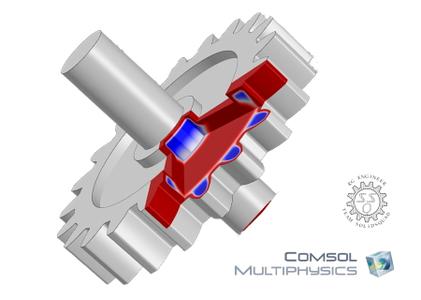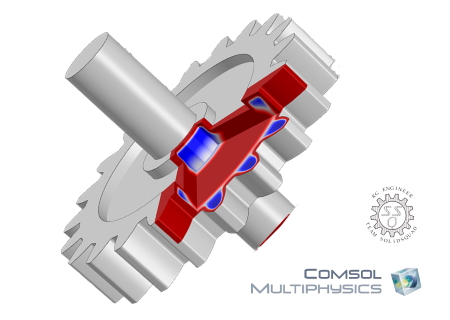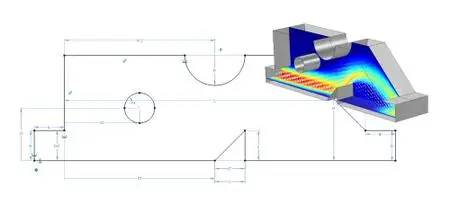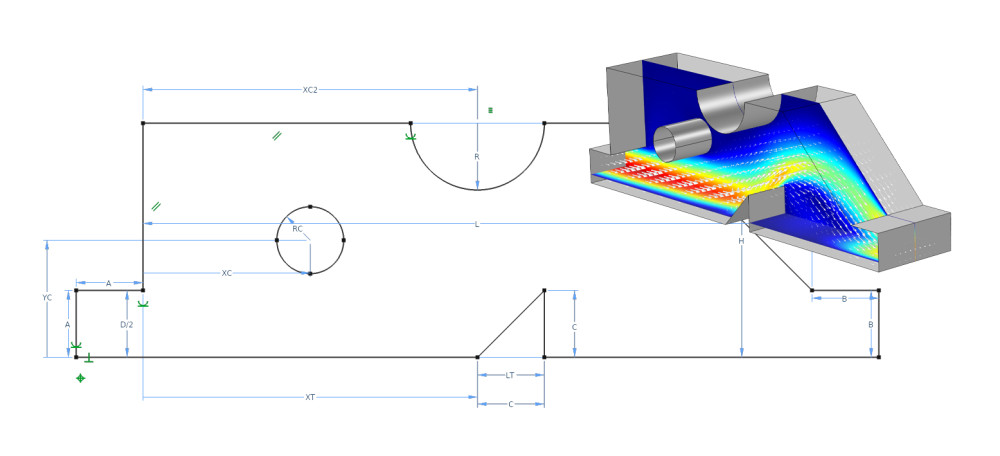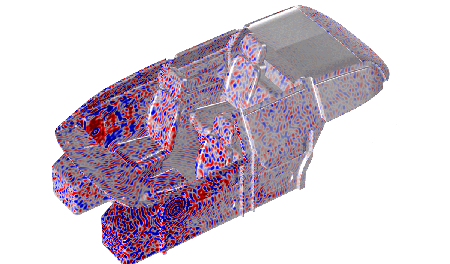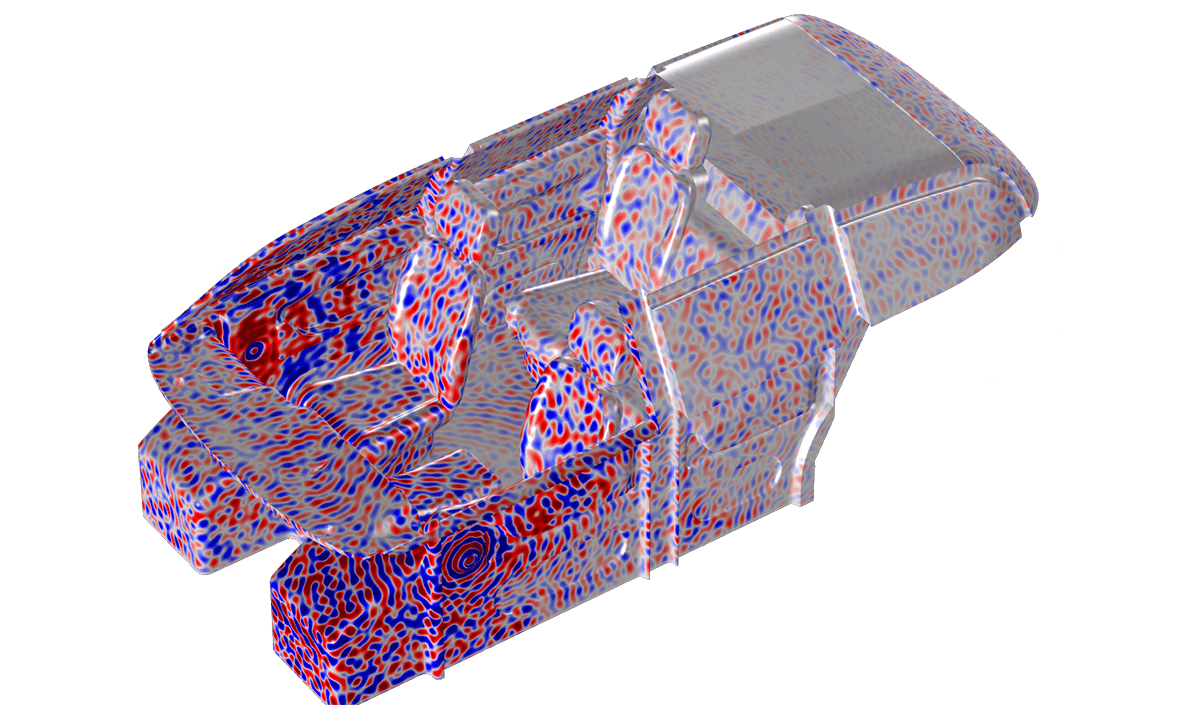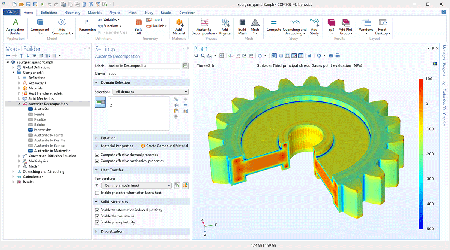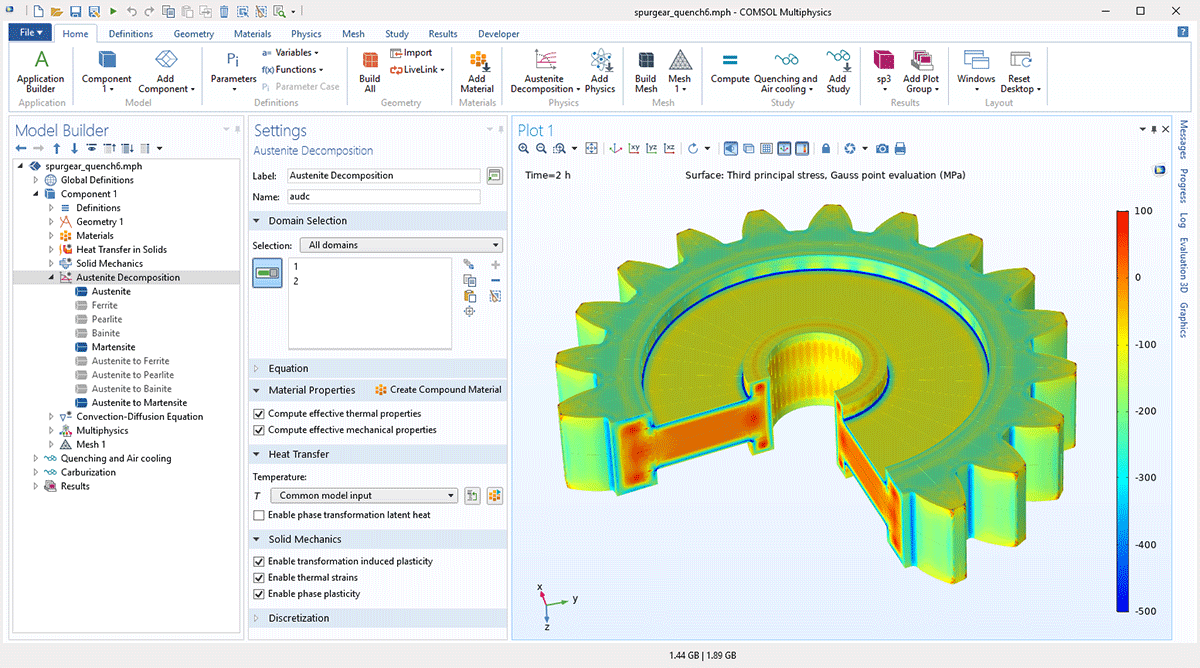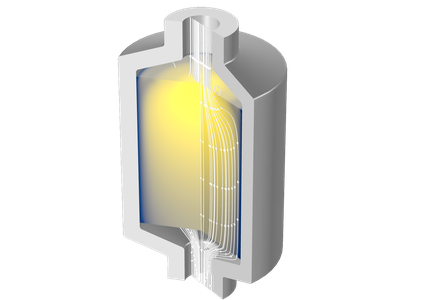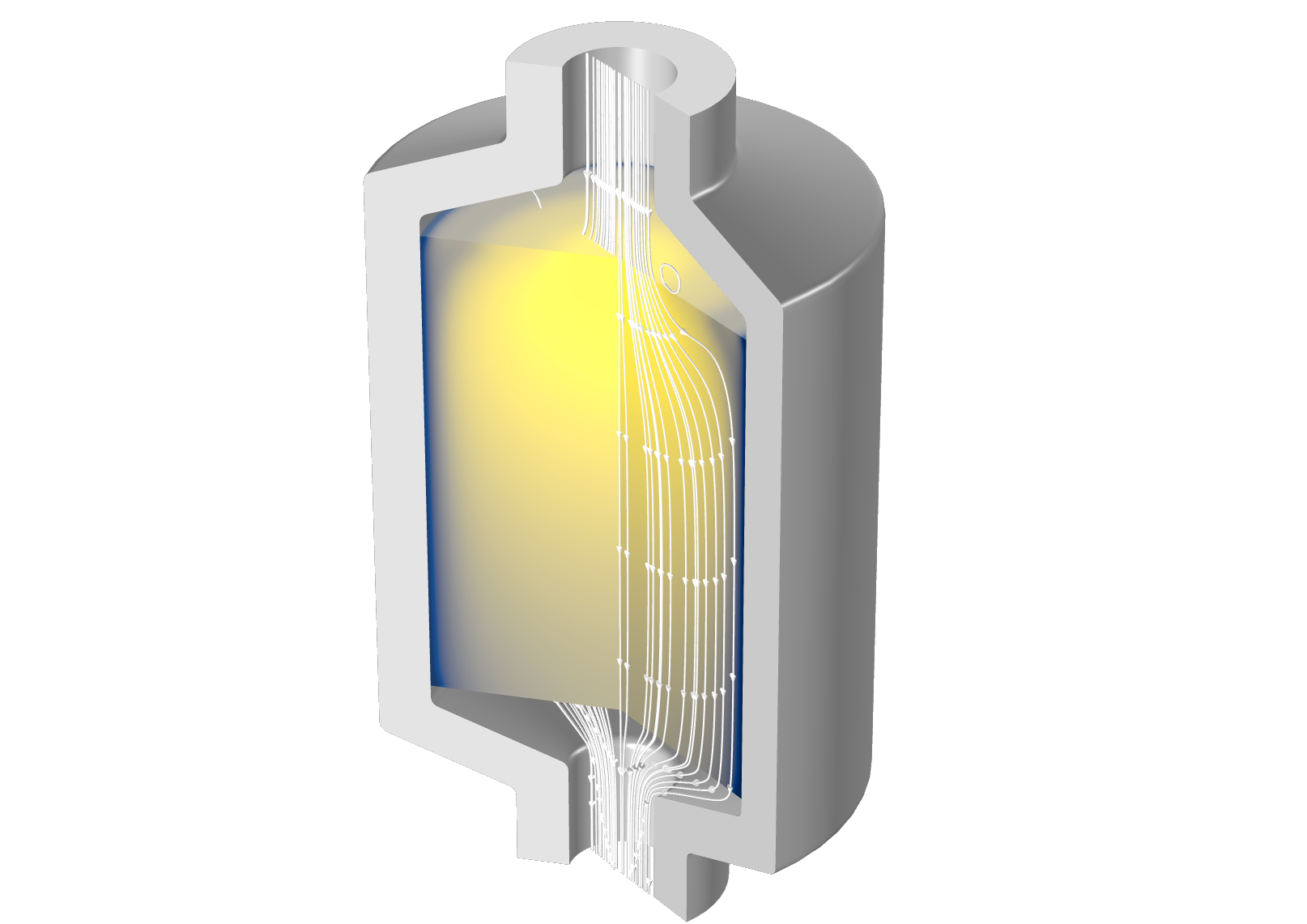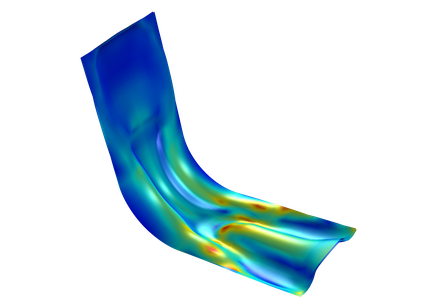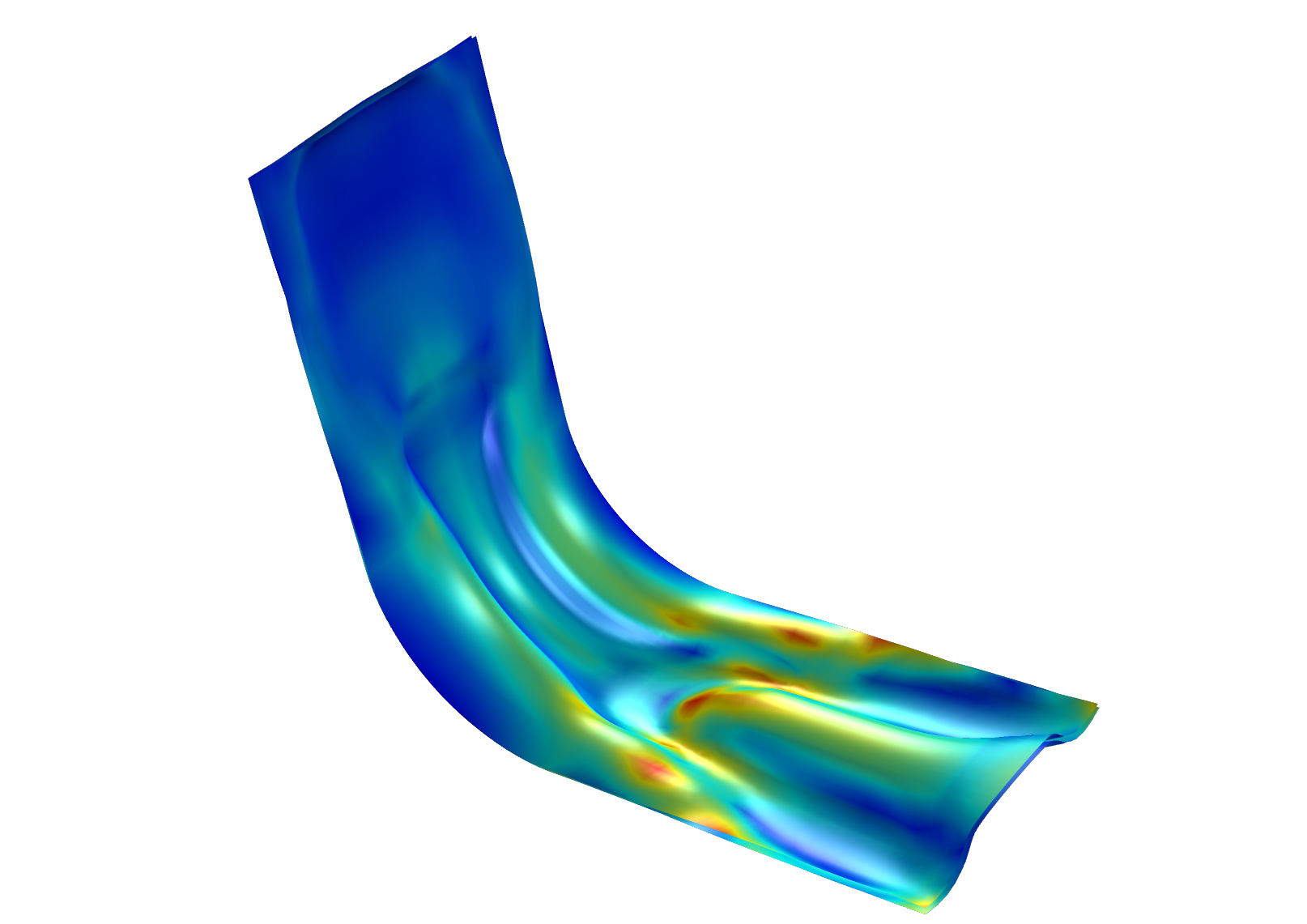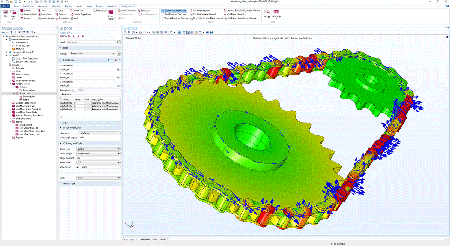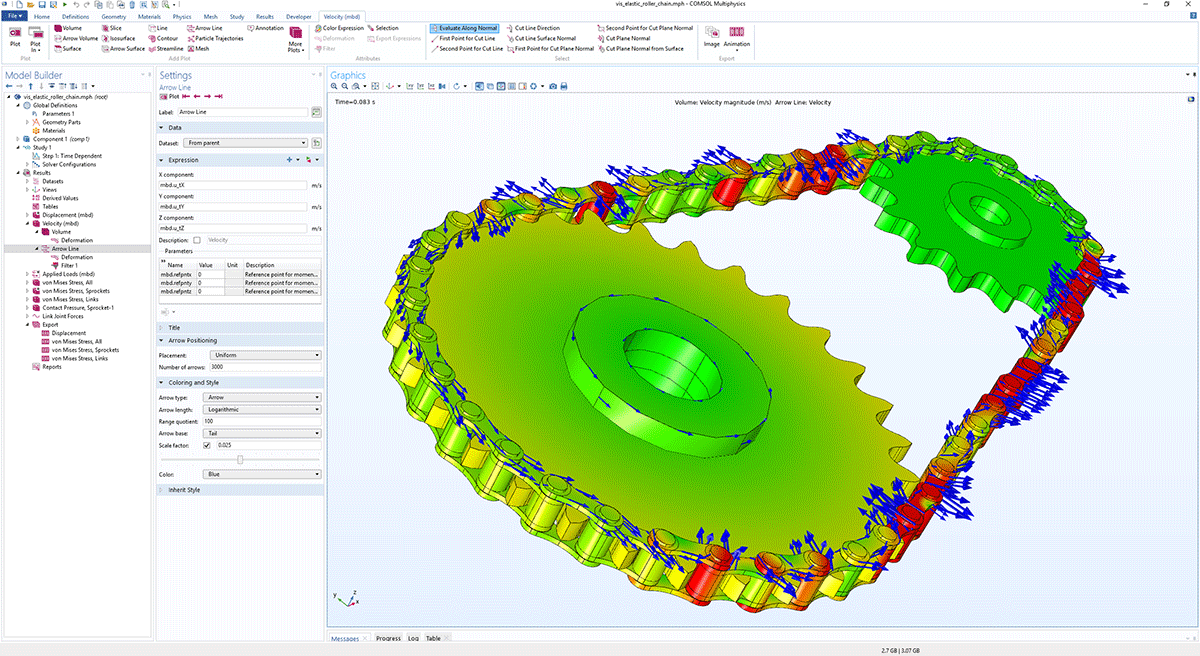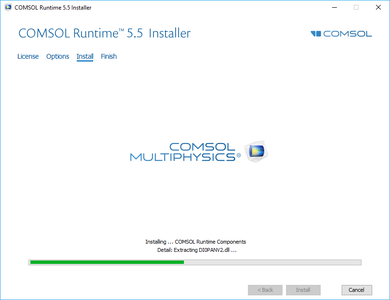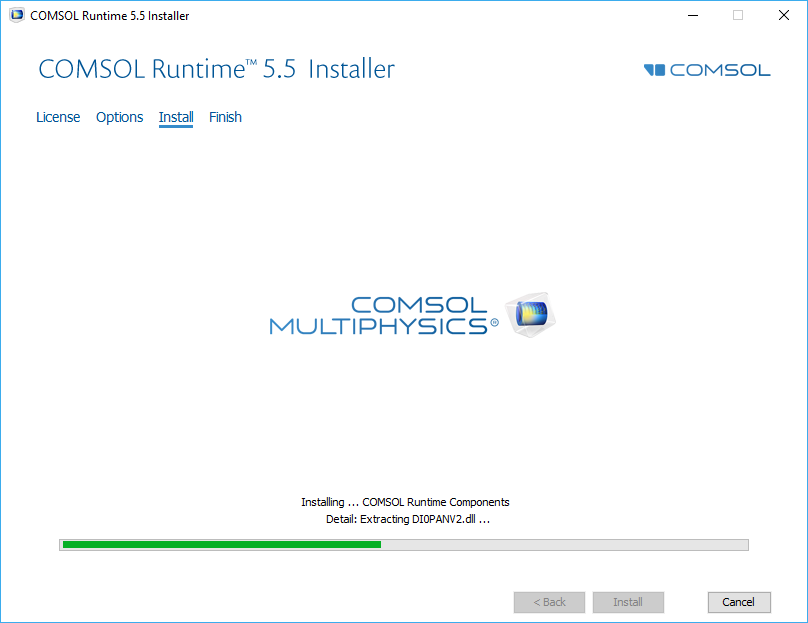Comsol Multiphysics 5.5 | 4.5 Gb
The Comsol product team is pleased to announce the availability of COMSOL Multiphysics 5.5. This release includes the new Metal Processing Module and Porous Media Flow Module; extended and improved versions of the Application Builder, COMSOL Compiler, COMSOL Server, and COMSOL Multiphysics; as well as updates and improvements for all COMSOL Multiphysics add-on products.
Comsol Multiphysics 5.5 general review
Powerful Parametric Sketching with Dimensions
The Design Module provides a new sketching tool that makes it easy to assign dimensions and constraints to planar drawings for 2D models and 3D work planes.
New Solver Technology for Acoustics Simulations
Ultrasound technology is becoming increasingly important in a wide range of applications spanning from process engineering and nondestructive testing to consumer electronics. New functionality based on the time-explicit discontinuous Galerkin method enables efficient multicore computations of ultrasound propagation in solids and fluids, including realistic materials featuring damping and anisotropy. The method also has low-frequency applications, such as in seismology. The included multiphysics capabilities can seamlessly combine linear elastic wave propagation in a solid and its transition to a fluid as an acoustic pressure wave, and back again. The new elastic wave functionality is available for users of the Structural Mechanics Module, MEMS Module, and Acoustics Module. The fluid-structure acoustics coupling is available in the Acoustics Module.
For frequency-domain simulations, a specialized solver for wave propagation analysis makes it possible to handle higher frequencies (shorter wavelengths) using the finite element method. The new solver can be used to analyze enclosed structures such as that of a car cabin interior as well as other acoustics simulations.
Introducing the Metal Processing Module
The new Metal Processing Module makes metal phase transformation analysis accessible within the COMSOL Multiphysics environment for applications within welding, heat treatment, and metal additive manufacturing.
Introducing the Porous Media Flow Module
The Porous Media Flow Module gives users within, for example, food, pharmaceutical, and biomedical industries a wide range of transport analysis capabilities for porous media. The new add-on product includes functionality for single- and multiphase flow in porous media, drying, and transport in fractures. The flow models cover linear and nonlinear flow in saturated and variably saturated media with special options for slow and fast porous media flows. The multiphysics simulation capabilities are extensive, with functionality that includes options for calculating effective thermal properties for multicomponent systems; poroelasticity; and transport of chemical species in solid, liquid, and gas phases.
Simplified Shape and Topology Optimization with the Optimization Module
Users working with mechanical, acoustics, electromagnetics, heat, fluid, and chemical analysis have been able to perform shape and topology optimization in COMSOL Multiphysics for many years. The Optimization Module now offers simplified setup of shape optimization with new built-in features such as moving boundaries parameterized by polynomials and built-in support for shell thickness optimization. A new smoothing operation for topology optimization ensures higher-quality geometry outputs that can be used for additional analysis and additive manufacturing. COMSOL Multiphysics now has general support for import and export of the additive manufacturing formats PLY and 3MF, in addition to the STL format that is already available.
Nonlinear Shell Analysis, Pipe Mechanics, and Random Vibration Analysis
A wide range of nonlinear analysis options are now available for shells and composite shells, including plasticity, creep, viscoplasticity, viscoelasticity, hyperelasticity, and mechanical contact. The mechanical contact modeling functionality has been extended to support any combination of solids and shells, including solid-shell, solid-composite shell, and membrane-shell. Depending on the type of analysis, these improvements will be available to users of the Structural Mechanics Module, Nonlinear Structural Materials Module, and Composite Materials Module.
For users of the Structural Mechanics Module, a new user interface for pipe mechanics provides functionality to perform stress analysis of pipe systems. The new functionality can handle a variety of pipe cross sections and can include effects from external loads, internal pressure, axial drag forces, and temperature gradients through the pipe wall.
Users of the Structural Mechanics Module can now perform random vibration analysis to study the response to loads that are represented by their power spectral density (PSD).
This allows users to include loads that are random in nature, such as turbulent wind gusts or road-induced vibrations on a vehicle. The loads can be fully correlated, uncorrelated, or have a specific user-given correlation.
The Multibody Dynamics Module provides new functionality for analyzing rigid and elastic chain drives with automatic generation of the large number of links and joints needed for modeling chain drives.
Compressible Euler Flow and Nonisothermal Large Eddy Simulations
Users of the CFD Module will get new interfaces for compressible Euler flow and nonisothermal large eddy simulations (LES). In addition, the flow interfaces for rotating machinery now support the level set and phase field methods as well as Euler–Euler and bubbly flow. The Heat Transfer Module comes with a new interface for lumped thermal systems, an equivalent circuit modeling approach for heat transfer simulations. Radiation in semitransparent (participating) media now supports multiple spectral bands, and a new open boundary formulation for convective flow reduces solution time by 30%.
Multiscale Wave and Ray Optics, Piezoelectric Shells, and PCB Ports
The Ray Optics Module can now be combined with the RF Module or Wave Optics Module for simultaneous full-wave and ray tracing simulations. This enables multiscale modeling, such as analyzing a waveguide beaming into a large room, where using a full-wave simulation would be computationally prohibitive. Combining the AC/DC Module and the Composite Materials Module, users can now analyze layered materials with both dielectric and piezoelectric layers in thin structures. In the RF Module, a set of new ports for vias and transmission lines makes setup much quicker and gives more control to the user for modeling of printed circuit boards.
Efficient Distribution of Standalone Applications
COMSOL Compiler enables you to create standalone applications based on COMSOL Multiphysics models with specialized user interfaces that have been built with the Application Builder. Compiled applications require only COMSOL Runtime — no COMSOL Multiphysics or COMSOL Server license is required. “Since the release of COMSOL Compiler last fall, we have seen great response from our Application Builder users with this new possibility of distributing their applications in standalone form,” said Daniel Ericsson, application product manager at COMSOL. The latest version of COMSOL Compiler has a new compile option for generating minimum-sized files for easier distribution. When the user launches an application for the first time, where the new compile option has been used, COMSOL Runtime is downloaded and installed, if needed, from COMSOL’s website. Only one instance of COMSOL Runtime is needed for applications using the same COMSOL version. COMSOL Runtime has a size of about 350 MB and an application file can be as small as a few MB.
General Updates
- New sketching tools for easier creation of 2D drawings
- Dimensions and constraints for drawings with the Design Module
- Safe placement of higher-order nodes for meshing
- New tools for editing additive manufacturing, 3D printing, and 3D scanning formats
- PLY and 3MF import and export
- Context menu in the Graphics window
- Keep enabled option for select box, deselect box, and zoom box
- Customize the Graphics toolbar
- Performance improvements for cluster computing
- Custom gradient between two colors in plots
- Animation of points and arrows for streamline plots
- Export images directly to PowerPoint®
- Create your own add-ins for customizing the Model Builder workflow
- Minimum-sized standalone application files with COMSOL Compiler™
Fluid Flow and Heat Transfer
- New product: Porous Media Flow Module
- New product: Metal Processing Module
- Lumped thermal systems circuit equivalents
- Multiple spectral bands in radiation in participating media
- Nonisothermal large eddy simulation (LES)
- Compressible Euler flow
- Bubbly flow, Euler–Euler, level set, and phase field models for flow in rotating machinery
- Viscoelastic flow
- Arbitrary number of dispersed phases
Electromagnetics
- Piezoelectric and dielectric shells
- New Lorentz Force feature
- Direct TEM and via ports for printed circuit board simulations
- Mixed-mode S-parameters
- New specific absorption rate (SAR) calculation feature
- Matched and scattering boundary conditions for Gaussian beams
- Evanescent Gaussian background fields
- Periodic port variables for polarization determination
- Full-wave electromagnetics to ray optics coupling
- Automatic spot diagram calculation
- Compute the electron energy distribution function (EEDF) in space-dependent problems
- Corona Discharge interface for modeling of electrostatic precipitators
- Electrical Breakdown Detection interface to predict whether electrical breakdown will occur
Structural Mechanics and Acoustics
- Mechanical contact for shells, composites, and membranes
- Plasticity and other nonlinear material models for shells and composites
- New Pipe Mechanics interface
- Piezoelectric and dielectric shells with the AC/DC Module
- Random vibration analysis
- Nonisothermal fluid-structure interaction (FSI)
- Fast linear elastic wave analysis with structure-fluid coupling
- Ports for thermoviscous acoustics analysis
- 3D-to-1D pipe acoustics coupling
- Structural-acoustics interactions for composite shells
- Smooth mapping for using CFD results in aeroacoustics
Chemical
- Generate materials and Chemistry interfaces from the thermodynamics database
- Electrochemical reactions in the Chemistry interface
- Current distribution in pipes
- Predefined Short Circuit feature for lumped battery simulations
Optimization
- Built-in tools for shape optimization
- Shape optimization on shells
- Smoothed geometry models from topology optimization results
- Confidence intervals for parameter estimation
Particle Tracing
- Extensions to built-in forces for Particle Tracing for Fluid Flow, including virtual mass and pressure gradient forces
- Computation time reduced by more than 50% for some particle tracing models
CAD Import Module, Design Module, and LiveLink Products for CAD
- Associative geometry import
- Selections from materials, layers, and colors
- Delete holes defeaturing operation
- Export to IGES and STEP
- New sketching tools for easier creation of 2D drawings
- Dimensions and constraints for drawings with the Design Module
- Safe placement of higher-order nodes for meshing
- New tools for editing additive manufacturing, 3D printing, and 3D scanning formats
- PLY and 3MF import and export
- Context menu in the Graphics window
- Keep enabled option for select box, deselect box, and zoom box
- Customize the Graphics toolbar
- Performance improvements for cluster computing
- Custom gradient between two colors in plots
- Animation of points and arrows for streamline plots
- Export images directly to PowerPoint®
- Create your own add-ins for customizing the Model Builder workflow
- Minimum-sized standalone application files with COMSOL Compiler™
Fluid Flow and Heat Transfer
- New product: Porous Media Flow Module
- New product: Metal Processing Module
- Lumped thermal systems circuit equivalents
- Multiple spectral bands in radiation in participating media
- Nonisothermal large eddy simulation (LES)
- Compressible Euler flow
- Bubbly flow, Euler–Euler, level set, and phase field models for flow in rotating machinery
- Viscoelastic flow
- Arbitrary number of dispersed phases
Electromagnetics
- Piezoelectric and dielectric shells
- New Lorentz Force feature
- Direct TEM and via ports for printed circuit board simulations
- Mixed-mode S-parameters
- New specific absorption rate (SAR) calculation feature
- Matched and scattering boundary conditions for Gaussian beams
- Evanescent Gaussian background fields
- Periodic port variables for polarization determination
- Full-wave electromagnetics to ray optics coupling
- Automatic spot diagram calculation
- Compute the electron energy distribution function (EEDF) in space-dependent problems
- Corona Discharge interface for modeling of electrostatic precipitators
- Electrical Breakdown Detection interface to predict whether electrical breakdown will occur
Structural Mechanics and Acoustics
- Mechanical contact for shells, composites, and membranes
- Plasticity and other nonlinear material models for shells and composites
- New Pipe Mechanics interface
- Piezoelectric and dielectric shells with the AC/DC Module
- Random vibration analysis
- Nonisothermal fluid-structure interaction (FSI)
- Fast linear elastic wave analysis with structure-fluid coupling
- Ports for thermoviscous acoustics analysis
- 3D-to-1D pipe acoustics coupling
- Structural-acoustics interactions for composite shells
- Smooth mapping for using CFD results in aeroacoustics
Chemical
- Generate materials and Chemistry interfaces from the thermodynamics database
- Electrochemical reactions in the Chemistry interface
- Current distribution in pipes
- Predefined Short Circuit feature for lumped battery simulations
Optimization
- Built-in tools for shape optimization
- Shape optimization on shells
- Smoothed geometry models from topology optimization results
- Confidence intervals for parameter estimation
Particle Tracing
- Extensions to built-in forces for Particle Tracing for Fluid Flow, including virtual mass and pressure gradient forces
- Computation time reduced by more than 50% for some particle tracing models
CAD Import Module, Design Module, and LiveLink Products for CAD
- Associative geometry import
- Selections from materials, layers, and colors
- Delete holes defeaturing operation
- Export to IGES and STEP
This file (COMSOL_ReleaseNotes.pdf) lists all the new module and updated features and also bug fixes that are available in last release.
BURLINGTON, MA, Nov 18, 2019 – COMSOL, the leading provider of software solutions for multiphysics modeling, simulation, and application design and deployment, announces the latest version of its COMSOL Multiphysics software. In version 5.5, the Design Module provides an entirely new sketching tool for easier creation and more versatile parametric control of geometry models. New and updated solvers speed up a wide range of simulations. Two new add-on products, the Porous Media Flow Module and the Metal Processing Module, further expand the product suite’s multiphysics modeling power.
COMSOL Inc. is a global provider of simulation software for product design and research to technical enterprises, research labs, and universities. Its COMSOL Multiphysics product is an integrated software environment for creating physics-based models and simulation applications. A particular strength is its ability to account for coupled or multiphysics phenomena. Add-on products expand the simulation platform for electromagnetics, structural, acoustics, fluid flow, heat transfer, and chemical applications. Interfacing tools enable the integration of COMSOL Multiphysics simulations with all major technical computing and CAD tools on the CAE market. Simulation experts rely on COMSOL Server to deploy applications to their design teams, manufacturing departments, test laboratories, and customers throughout the world. Founded in 1986, COMSOL has 19 offices worldwide and extends its reach with a network of distributors.
Product: Comsol Multiphysics
Version: 5.5.0 Build 292
Supported Architectures: x64
Website Home Page : www.comsol.com
Language: multilanguage
System Requirements: PC / macOs / Linux *
Supported Operating Systems: *
Size: 4.5 Gb
These requirements are common to all platforms:
- A working network card and internet connection are recommended during installation
- At least 4 GB of RAM is recommended
- 2–10 GB of disk space, depending on your licensed products and installation options
- Adobe Acrobat Reader to view and print the COMSOL documentation in PDF format
- An Intel or AMD 64-bit processor based on the Intel 64 or AMD64 architecture *
* A processor with the SSE4 instruction set is required for the Design Module on Linux. Intel processors released 2009 or later and AMD processors released 2012 or later satisfy this requirement.
Operating System Requirements
Windows 10
Windows 10 Pro for Workstations
Windows 8.1
Windows 7 SP1
Windows Server 2019
Windows Server 2016
Windows Server 2012 R2
Windows Server 2012
Windows Server 2008 R2 SP1
Windows HPC Server 2008 R2 SP1
macOS 10.13, 10.14, and 10.15
Debian 8, 9 and 10
Red Hat Enterprise Linux 7.7 and 8.0
CentOS 7.7 and 8.0
Ubuntu 16.04, and 18.04
SUSE Linux Enterprise Desktop 15 SP1
OpenSUSE Leap 15 and 15.1
- A working network card and internet connection are recommended during installation
- At least 4 GB of RAM is recommended
- 2–10 GB of disk space, depending on your licensed products and installation options
- Adobe Acrobat Reader to view and print the COMSOL documentation in PDF format
- An Intel or AMD 64-bit processor based on the Intel 64 or AMD64 architecture *
* A processor with the SSE4 instruction set is required for the Design Module on Linux. Intel processors released 2009 or later and AMD processors released 2012 or later satisfy this requirement.
Operating System Requirements
Windows 10
Windows 10 Pro for Workstations
Windows 8.1
Windows 7 SP1
Windows Server 2019
Windows Server 2016
Windows Server 2012 R2
Windows Server 2012
Windows Server 2008 R2 SP1
Windows HPC Server 2008 R2 SP1
macOS 10.13, 10.14, and 10.15
Debian 8, 9 and 10
Red Hat Enterprise Linux 7.7 and 8.0
CentOS 7.7 and 8.0
Ubuntu 16.04, and 18.04
SUSE Linux Enterprise Desktop 15 SP1
OpenSUSE Leap 15 and 15.1
Please visit my blog
Added by 3% of the overall size of the archive of information for the restoration
No mirrors please
Added by 3% of the overall size of the archive of information for the restoration
No mirrors please


